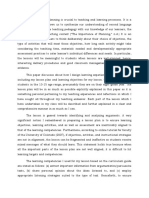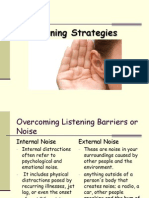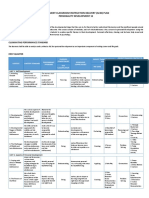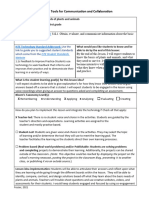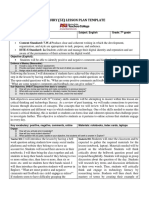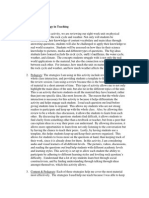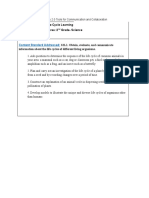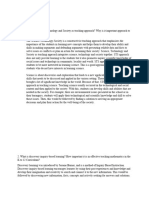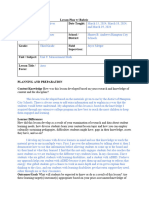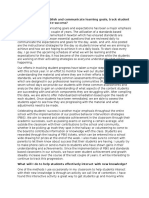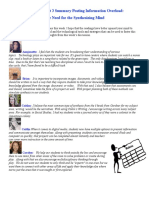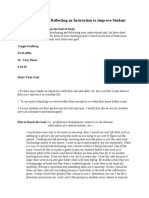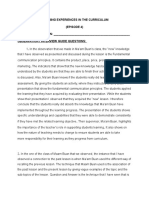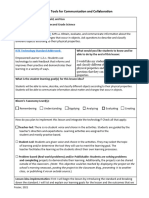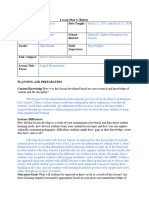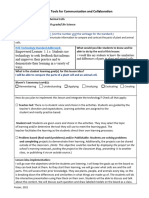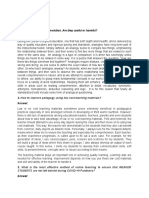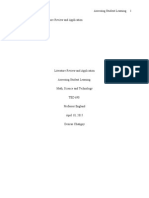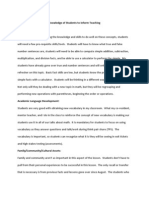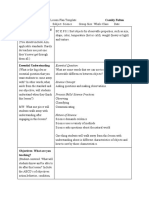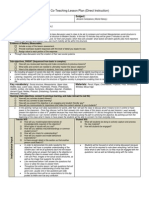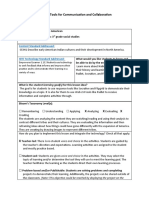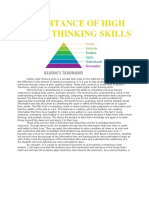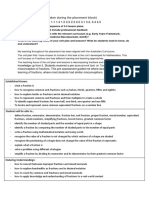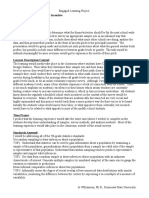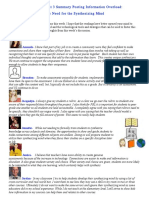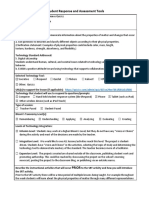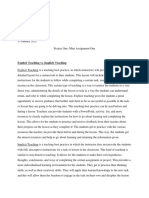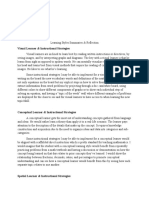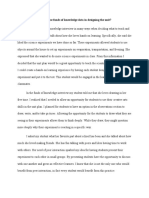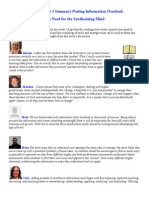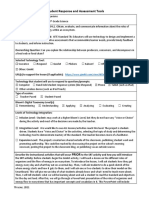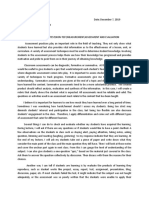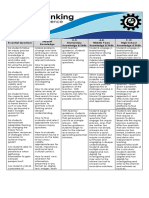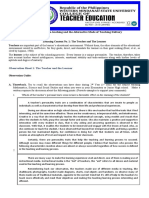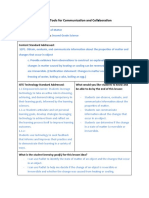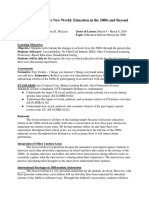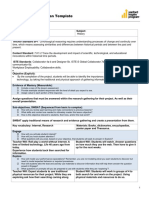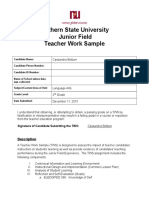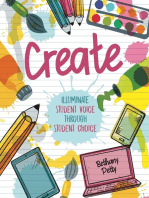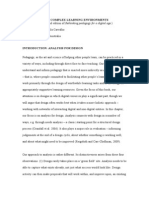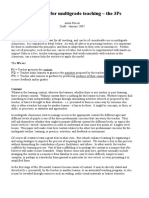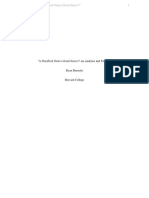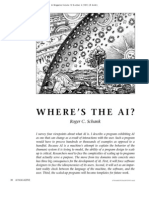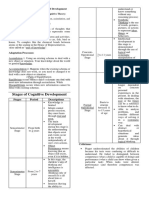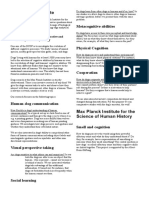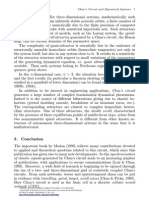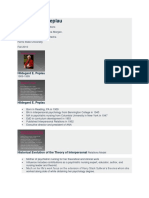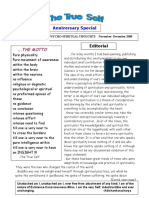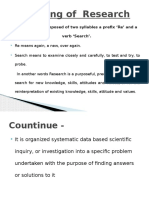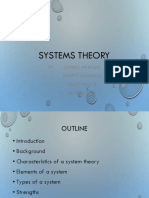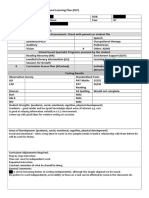Professional Documents
Culture Documents
Schema
Schema
Uploaded by
api-180875253Original Description:
Original Title
Copyright
Available Formats
Share this document
Did you find this document useful?
Is this content inappropriate?
Report this DocumentCopyright:
Available Formats
Schema
Schema
Uploaded by
api-180875253Copyright:
Available Formats
This is the form of assessment that I use the most, especially in science.
This type of assessment allows me to see how students use the scientific processes to work through science projects and use their prior knowledge to learn content. Much of this typ e o f assessment for me is observation and oral questioning. I ask students to demonstrate what they have learned and explain how they learned. It is difficult for my students to write explanations as they are 7 so many times it is pictures with verbal explanations. I take notes on their pictures as to what they are explaining and photograph any experiments and projects that are created. I like this assessment as it really shows me depth of knowledge and not just vocabulary. I can see how the students work and how they determine content and how the content works. This assessment is added to the portfolios.
I will use this type of assessment as formative and summative. I use the iRespond system so I have instant feedback as to how well the students are learning and areas that they may need to work on. I use this type of assessment to assess vocabulary for content being taught and image recognition. Since I teach firs t grade I don't use this for m o f assessment as much as I do constructed response type questions. This assessment is not as in-depth for science so it is just a basic form of assessment.
There are many types of formative assessments that I take for all areas of content. I will take notes as we have discussions. I will also have a worksheet or paper tes t that the students will complete. While working in pairs or collaborative groups I will assess how the students work and ask questions. I will observe students in experiments and research projects and see if they can explain what they are researching and experimenting with. Having the groups and/or students explain and share with the class what they have learned is another way that I will assess learning and knowledge base.
For the student portfolios I will add conferencing notes that I have with the students. I will also add any photos of experiments that the students work with and explanations with each photo. Students can also add any notes that they take during group discussions and projects. Formative assessments will be added as well as summative assessments to show student growth in knowledge and understanding. Any research projects that the students complete will be added as well. To get a grade for each content area I will meet with each student and discuss all the artifacts that are in each portfolio and discuss what they have learned. I will orally ask students to explain what is in their portfolio and a grade will be determined from there.
In order to keep up with the incremental trends I will need to keep learning throughout my teaching career. I will need to continue learning the new technologies that are becoming available and know how to use them. The population of my students will change and I will need to keep up with different cultures and how to teach students that are on varied learning levels.
I have access to several programs at school that the students can use to work independently on the computer and they receive instant assessments and feedback from the programs. I use these programs not as assessments but as a guide to see what the students know and I can alter instruction as necessary. These programs are a great way to gain knowledge on student knowledge of content.
With all the student friendly virtual libraries, my students can freely and safely research a science topic . I also have a collection of science WebQuests that the students complete in pairs on the classroom computers. I offer support for the pairs but the students work these assignments together.
Extended Response Assessments are much more in-depth and allow for the instructor to assess knowledge on multiple levels as opposed to a single answer in Selected Response. Extended Response can be essay, short answer or questions that require students to show work and explain how an answer was reached. These are ver y effective assessments as they give the teacher a much better idea of understanding content from the students.
Selected Response Assessments are multiple choice assessments. The wording for these assessments must be carefully selected as not to confuse the students as to what content the assessment is about.
Formative Assessments are assessments that are taken to show what the student's know and areas that they don't know. Formatives are not used to grade officially but are used to drive instruction and provide the instructor with information regarding content knowledge.
Student Portfolio is a collection o f student's work that show growth and multiple ways students work to learn. A portfolio can include student reflections, photos of students working, worksheets, journaling, tests or assessments and conference notes. Anything can be added to a portfolio that is part of a student's learning.
Incremental Trends are forces that have changed over the centuries. There is more information available and mass amounts of different technology and media available. Information that should be taught is ever changing.
In order to work with the students in these two stages I will need a lot of different ways for them to learn. I will use leveled readers, videos, and hands on learning. I will also use a variety of technologies to assist in the learning process. I will use a Smartboard, online games, websites, iPads and digital cameras. Allowing the students to learn using all these different resources will give the students multiple perspectives of a concept. The students will use their journals to record the concept they learned and the ways they liked learning the best.
Pre-Operations Stage - Students think in one direction. They play pretend and have a hard time thinking from others point of views. Concrete Operational Stage Students begin to reason and sort and classify information. They begin to think forward and backwards to solve problems.
Rather than using the terms rewards and punishments, I would give positive praise when a student is heading in the correct direction with an assignment and gaining knowledge to learn a concept. That would be the reward. The punishment I would consider more of a positive re-direction if a student is not learning a concept or heading the wrong direction to gain knowledge. I would work with the student to help them move towards the correct path of the concept being learned.
Selected Response Multiple Choice
Formative Assessments
Student Portfolios
Incremental Trends
Piaget's Theory Pre-Operational Stage moving in to Concrete Operational Stage
Children learn by actions of those around them. A correct response will get a reward and an incorrect response will receive punishment.
This is another great strategy for science. I will present the students with a problem. As an example, figuring out what items are magnetic and what aren't. After researching in the internet and class discussions, I would break the students into groups and give them magnets and several sets of objects. The groups can experiment and journal their experiments. They will discuss what they know and what they are learning with the experiments. After working together the class will come back together as a whole and discuss what they learned. They will discuss the different experiments they created and the results of the experiments.
Computers are and allow for internet research and learning. Supplements teachers lessons. Presents students with content and provides feedback and assesses performance. Complete learner centered strategy. Students do no t have designated roles in their groups and interactions among the group members is free. Good problem solving strategy for groups as it allows for open exchange and trials.
Extended Response or Constructed Response Students Show Work
Kohlberg's Theory of M oral Reasoning Preconventional M orality
Computer MediatedCommunication
Vygotsky's Perspective Social Development
His ideas were that social interactions and language development helped children grow in their mental abilities. He thought that children's development shifted with social contact and putting their thoughts into words.
Using the ideas of Vygotsky I would have students complete assignments in small groups or collaborative pairs. They will work assignments together and discuss what they are doing using the terms and vocabulary of the concept. They can journal and write about the concept using the vocabulary and describing what they have learned and how a concept works.
Computer Assisted Instruction
This strategy is perfect for teaching science to my first graders. One science subject that we study is sound. Students need to learn about pitch, volume and sound waves. I will split the class into groups and give them internet access and a sound term. The groups can research using child friendly sites to help them understand what the terms are. Then I would give them various items to create examples of the terms to share and explain with the rest of the class. We would then create a sound presentation on PowerPoint. The students would decide what the important key details and facts are and take the pictures for the presentation.
Erikson's Theory
Project based instruction where students work together to complete an assigned or chosen topic. Students form their own groups and selects an area of content they want to study and research. After the research is complete, all groups share what they learned with the rest of the class.
Studentinteractive Learning
Industry vs. Inferiority
Group Investigation Teaching Strategies for First Grade Science Students.
Maslow defined the needs of students in two categories. 1. Deficiency Needs - Needs relate to feeling safe, feeling love and belonging. 2. Growth Needs - Quest fo r knowledge and curiosity and interests
In this stage, children will work new tasks and assignments either independently or collaborative pairs. By working with others or by themselves and completing a task or assignment, the students have a feeling of competency towards a concept rather than feel inferior because they don't fully understand and did not complete a task.
I would use much of the same type of assignments as I did with the ideas of Vygotsky. Students will work with collaborative pairs to complete assignments and discuss what they have done to complete the task and what they learned. I would still use a journal for students to express what they have learned and they can describe the learning in their own words to better understand the concept.
Prior Knowledge
Maslow's Hierarchy of Needs Transfer of Knowledge Goal Orientation
Since some of the science concepts that I will be introducing may be new to my students I would need to assess whether or not any of them have prior knowledge of the concept. I can do this by talking with the students, having them watch a video streaming on the subject then having a group discussion or I can use a pre-test about the concept. From this I can gauge prior knowledge and edit my instruction for the different levels of knowledg e from my students. What a person already knows and believes. This knowledge can be positive or negative.
Using the Maslow's Hierarchy I would make sure that the students are comfortable in their surroundings in school and with the concepts. I will give the students opportunities to experiment and ask questions pertaining to the concepts being taught. They will work together to discuss and find higher knowledge together. If a student is working in the wrong direction I will help guide the student back to the co r r e c t direction by asking questions and allowing the student to apply what he knows to get back on track. Students will be able to pres e nt wha t they have learned and answer questions to apply their knowledge and understanding.
Mastery vs. Performance Goals Mastery - Focus in mastering task and understanding Performance - Focus on being smartest at the task or being superior
Acknowledge Students Efforts and Accomplishments
Interaction of Knowledge and Learning
Self Schemas
Students can often compare themselves to others based on their grades and failures easier than look at the work they put forth and feel good about the fac t that they tried their hardest and put forth 100% in their work Knowledge and learning are two separate concepts. In order to t o gain the knowledge, students must learn and apply what they have learned to have a concept become knowledge. Learning occurs in all areas of a person's life and not just in the classroom. Using what they have learned with help them gain knowledge and ask questions to further their knowledge base.
In order for a student to transfer knowledge and truly understand a concept, they must be able to apply what they have learned and explain the concept in different ways and in different situations.
I want to encourage students to take risks and not just master a concept. I will provide opportunities through technology, hands-on learning, collaboration and research to go beyond just the mastery of a concept. I wa nt the conversation to go beyond only the standard. Students will work together and we will discuss how these concepts can be found in their real world lives and how they can apply what they have learned in multiple ways.
Sternberg's Triarchic Theory
Knowledge Reflection Problem Solving Strategic Thinking Strategic Repertoire
Every student should feel proud in they put forth their best efforts in learning a concep t . I take grades on concepts through many different ways. When a student can't write the answer in a way they understand it, I ask them to explain it to me. This makes the student feel that their efforts have not go ne unnoticed. I am always asking the students how they are doing and praising the work they are putting forth. For the collaborative pairs I try and pair students that are motivated by science with students that may not like science as much. Usually the motivation of the scientifically driven student helps drive the unmotivated student to learn more and ask questions. I praise the students for putting forth their best effort s even if they still have difficulty in the concept. I always tell my students all I want from them is their best work. Acknowledging
Self Schemas are perceptions that students have about themselves. They are based on the past and present state of a student. The s e Schemas can be positive or negative for a student and can affect the way the student works to solve problems or concepts.
1. Traditional measures of intelligence such as IQ tests capture only a part of what is means to be intelligent. 2. Intelligence is the ability to adapt flexib ly and effectively to the environment. 3. More than mere analytical ability, humans need creative and practical abilities to succeed in their life pursuits. 1. Teacher Example 2. Organizations 3. Discussions 4. Guidelines for Assignment Knowledge reflection is experiences in and out of school. I will demonstrate for the students strategic thinking. I will have them ask questions about the concept and show them how to research. I will demonstrate how the concept is used in everyday life. 1. Information Search 2. Predicting 3. Concept Mapping 4. Goal Setting 5. Self Analysis
In my lessons, I will take what students already know and apply strategies to help them enhance that learning. Using the formal or inert knowledge and the explicit knowledge I will base lessons that will mesh these two forms of knowledge together and allow students to apply them and indentify with a concept and move forward with gaining more knowledge.
In my instruction and activities I will provide students with the opportunities to learn in multiple ways. They will use experiments, technology, (computers, SMARTBOARDS digital cameras, software , programs, WebQuests readings and ) writing to assist them with their learning. Using real world situations will help the students with the learning. I will encourage students to ask questions and set them up with assignments that contradict the concept and have them change the assignment so that it fits with what they have learned. I will challenge them to take what they have learned and show their friends and families the concept and demonstrate it for them.
Self Schemas are especially relevant in first grade where my students are learning how to read and write let alone learn social studies and science. Many students have told me that they can not write or they don't know math. This preconception of themselves can be damaging. If a student believes that he can't do something it can be hard to motivated them to try new concep t s . With this in mind I will use multiple ways for students to work and master these science concepts. I will use leveled readers about tha t concept. I also have technology that can r e a d the book to the student so they can hear the words as they read. If the student in uncomfortable writing, I have voice recorders tha t they can record their findings on and I can help them write it out later. Students may also draw pictures to illustrate what they are learning and explain what they drew verbally. By doing this I can change a negative self schema to a hopefully positive one and create motivation as well.
In using Sternberg'sTriarchic Theory I need to provide the students will multiple ways to adapt an assignment to fit their strengths in learning. I will provide multiple ways for the students to used their problem solving skills to strategic thinking to work with a science concept and truly understand it. I will offer technology research, leveled non-fiction readers, experiments, videos and worksheets that students can use to meet their needs to learn.
My first graders need to be taught how to problem solve effectively. I will ask them how they think we should solve an example problem. We will record the responses and talk about each one. Which ones would be the most effective and which ones can be changed to become more effective. I will outline the assignment for them and give them specific guidelines. With these guidelines the students will work together and use the problem solving techniques we have documented as a class. The groups will discuss together and then the class as a whole. Together we can elaborate on the problem solving skills that each group or pair used and decide which models were the most effective in helping to find the solution to the problem.
After demonstrating for students strategic thinking skills, I will break them into groups or pairs and assist them in coming up with their own deep thinking questions regarding what we are learning. Working together in their groups they will be able to research and experiment together to ask more questions and answer questions. They will come up with their own different ways these science concepts are used in everyday life and apply it to their lives. They will present their findings to the class so the class can ask questions and discuss each groups different ideas and answers.
As a teacher teaching science I would encourage the students to use their research skills onPebbleGo to find out more information about a science topic we are discussing. After doing research, I would ask them to predic t what they are going to learn about the science topic. Using a concept map to map what they have learned I would have them work in pairs to discuss and self assess their work. I would then assess them in my own way to make sure they understand the concept.
In order for the students to sho w knowledge, I will assess them through conferencing, work they complete, experiments and journaling about their learning experience. I will also have the students think of areas outside of the classroom that their knowledge could be useful. I will encourage them to find areas outside of school to use their knowledge.
Create PDF files without this message by purchasing novaPDF printer (http://www.novapdf.com)
You might also like
- Qualifying EssayDocument5 pagesQualifying EssayJoannie Dawn SagubanNo ratings yet
- Sample Research Internship Cover LetterDocument1 pageSample Research Internship Cover LetterHarshal PaunikarNo ratings yet
- Listening StrategiesDocument23 pagesListening StrategiesluismiguelmmercadoNo ratings yet
- Alignment Classroom Instruction Delivery (Acid) Plan Personality Development 12Document5 pagesAlignment Classroom Instruction Delivery (Acid) Plan Personality Development 12Sab IbarretaNo ratings yet
- Contextual LearningDocument11 pagesContextual Learningluck2ang100% (2)
- Web 2Document2 pagesWeb 2api-692395377No ratings yet
- Post-Conf From WebDocument4 pagesPost-Conf From WebLee Ann Spillane100% (1)
- Hart Inquiry Lesson Plan FinalDocument3 pagesHart Inquiry Lesson Plan Finalapi-488023420No ratings yet
- Hegarty Lesson Plan Cep800Document7 pagesHegarty Lesson Plan Cep800api-273086278No ratings yet
- Untitled Document 1Document4 pagesUntitled Document 1api-660788842No ratings yet
- What Is ScienceDocument5 pagesWhat Is Scienceliezelconsigna03No ratings yet
- Unit 9 - Measurement Lesson Plan 4Document5 pagesUnit 9 - Measurement Lesson Plan 4api-607301023No ratings yet
- What Will I Do To Establish and Communicate Learning Goals, Track Student Progress, and Celebrate Success?Document5 pagesWhat Will I Do To Establish and Communicate Learning Goals, Track Student Progress, and Celebrate Success?api-324555992No ratings yet
- EDIM 508 Unit 3 Summary Posting Information Overload: The Need For The Synthesizing MindDocument4 pagesEDIM 508 Unit 3 Summary Posting Information Overload: The Need For The Synthesizing MindktitraceNo ratings yet
- Lesson PlanDocument8 pagesLesson Planapi-296196628No ratings yet
- Step 7 Reflecting On Instuction To Improve StudentDocument3 pagesStep 7 Reflecting On Instuction To Improve Studentapi-663294846No ratings yet
- Episode 4 Field Study ObservationDocument5 pagesEpisode 4 Field Study ObservationDemy NodoraNo ratings yet
- Web 2.0 Communcation - and - CollaborationTools) Lesson PlanDocument3 pagesWeb 2.0 Communcation - and - CollaborationTools) Lesson PlanravenNo ratings yet
- Unit 9 - Measurement Lesson Plan 3Document5 pagesUnit 9 - Measurement Lesson Plan 3api-607301023No ratings yet
- Unit 9 - Measurement Lesson Plan 2Document5 pagesUnit 9 - Measurement Lesson Plan 2api-607301023No ratings yet
- Web 2Document2 pagesWeb 2api-724760203No ratings yet
- Argumentation and Debate LessonDocument6 pagesArgumentation and Debate Lessonapi-283604512No ratings yet
- Reflections1 5Document4 pagesReflections1 5api-301349748No ratings yet
- Activity No. 3 - Instructional MaterialsDocument6 pagesActivity No. 3 - Instructional MaterialsdarfrackzNo ratings yet
- Nicholas Mansour Web 2Document2 pagesNicholas Mansour Web 2api-691736066No ratings yet
- Unit 9 - Measurement Lesson Plan 5Document5 pagesUnit 9 - Measurement Lesson Plan 5api-607301023No ratings yet
- Literature Review of Assessing Student LearningDocument8 pagesLiterature Review of Assessing Student Learningapi-283267030No ratings yet
- EDIM 508 Unit 3 Summary Posting Information Overload: The Need For The Synthesizing MindDocument4 pagesEDIM 508 Unit 3 Summary Posting Information Overload: The Need For The Synthesizing MindktitraceNo ratings yet
- Planning CommentaryDocument7 pagesPlanning Commentarydarnelllogan8No ratings yet
- Science 5 ElessonplanDocument8 pagesScience 5 Elessonplanapi-340863506No ratings yet
- Direct World History LPDocument3 pagesDirect World History LPapi-265066614No ratings yet
- M4a LessonDocument3 pagesM4a Lessonapi-619251533No ratings yet
- Web 2Document3 pagesWeb 2api-619124298No ratings yet
- Reflection in Response To FeedbackDocument5 pagesReflection in Response To Feedbackapi-349579702No ratings yet
- Lesson Plan 3Document7 pagesLesson Plan 3api-337970110No ratings yet
- Alexia Murano - Learning Styles Multiple Intelligence Profile Assignment 1Document2 pagesAlexia Murano - Learning Styles Multiple Intelligence Profile Assignment 1api-524672921No ratings yet
- Importance of High Order Thinking SkillsDocument2 pagesImportance of High Order Thinking SkillsByron DizonNo ratings yet
- Tpa Activity 3Document3 pagesTpa Activity 3api-480040176No ratings yet
- FS1 - The Instructional CycleDocument2 pagesFS1 - The Instructional CycleLaurence SapigaNo ratings yet
- Web 2Document2 pagesWeb 2api-654276724No ratings yet
- Title of Project: School-Wide Incentive Subject(s) : Math Grade Level(s) : 7 AbstractDocument3 pagesTitle of Project: School-Wide Incentive Subject(s) : Math Grade Level(s) : 7 Abstractapi-290647272No ratings yet
- EDIM 508 Unit 3 Summary Posting Information Overload: The Need For The Synthesizing MindDocument4 pagesEDIM 508 Unit 3 Summary Posting Information Overload: The Need For The Synthesizing MindktitraceNo ratings yet
- m07 Student Response Tools Lesson Idea - Brittany AguilarDocument3 pagesm07 Student Response Tools Lesson Idea - Brittany Aguilarapi-565438825No ratings yet
- Project 1 Miniassignment 1Document3 pagesProject 1 Miniassignment 1api-596500164No ratings yet
- Learning Styles Reflection and SummariesDocument3 pagesLearning Styles Reflection and Summariesapi-652792108No ratings yet
- Artifact Reflection 2Document2 pagesArtifact Reflection 2api-548792025No ratings yet
- Unit ReflectionDocument9 pagesUnit Reflectionapi-426708730No ratings yet
- Pre-Observation Questions - PeerDocument6 pagesPre-Observation Questions - Peerapi-258317089No ratings yet
- Professional Inquiry Project ProposalDocument8 pagesProfessional Inquiry Project Proposalapi-427319867No ratings yet
- EDIM 508 Unit 3 Summary Posting Information Overload: The Need For The Synthesizing MindDocument5 pagesEDIM 508 Unit 3 Summary Posting Information Overload: The Need For The Synthesizing MindktitraceNo ratings yet
- Roles of Organism Lesson PlanDocument3 pagesRoles of Organism Lesson Planapi-540235024No ratings yet
- 25 Effective Instructional Strategies For EducatorsDocument9 pages25 Effective Instructional Strategies For Educatorsmohamed Darwish (ICT HOD)No ratings yet
- Jeric B. MaribaoDocument3 pagesJeric B. MaribaoJeric MaribaoNo ratings yet
- Reflections For Standard 1 1.A.3 Rigorous Standard-Based Unit DesignDocument3 pagesReflections For Standard 1 1.A.3 Rigorous Standard-Based Unit Designapi-317761911No ratings yet
- Assessment and Evaluation in The Online ClassroomDocument9 pagesAssessment and Evaluation in The Online Classroomsherry.simmons7943No ratings yet
- Essential Questions Student Knowledge K-3 Elementary Knowledge & Skills 4-8 Middle Years Knowledge & Skills 9-12 High School Knowledge & SkillsDocument3 pagesEssential Questions Student Knowledge K-3 Elementary Knowledge & Skills 4-8 Middle Years Knowledge & Skills 9-12 High School Knowledge & SkillsJennifer StewartNo ratings yet
- Project Based and Problem Based Learning SummaryDocument5 pagesProject Based and Problem Based Learning Summaryhusteadbetty100% (1)
- FS2 Worksheet 1Document4 pagesFS2 Worksheet 1Alwyn U. SacandalNo ratings yet
- Web 2Document5 pagesWeb 2api-594643332No ratings yet
- Lesson 4Document7 pagesLesson 4api-316937046No ratings yet
- Inquiry Based Lesson Plan Template RevisedDocument4 pagesInquiry Based Lesson Plan Template Revisedapi-433577692No ratings yet
- Northern State University Junior Field Teacher Work Sample: DescriptionDocument8 pagesNorthern State University Junior Field Teacher Work Sample: Descriptionapi-300518953No ratings yet
- Critical Analysis On Definition of Language by Edward SapirDocument5 pagesCritical Analysis On Definition of Language by Edward SapirCH Abdul Majid0% (1)
- The Analysis of Complex Learning EnvironmentsDocument24 pagesThe Analysis of Complex Learning Environmentspablor127100% (1)
- Geography Class 12 Fundamentals of Human GeographyDocument119 pagesGeography Class 12 Fundamentals of Human GeographyHemant ChourhaNo ratings yet
- Leadership Final ReflectionDocument2 pagesLeadership Final Reflectionapi-290880850100% (1)
- Creativity - Lateral ThinkingDocument17 pagesCreativity - Lateral ThinkingNeeraj JainNo ratings yet
- 3p's GuideDocument14 pages3p's GuideElla CustodioNo ratings yet
- Chapterwise Important Topics in Psychology PDFDocument7 pagesChapterwise Important Topics in Psychology PDFnavinnaithani100% (1)
- Does Google Make Us DumberDocument6 pagesDoes Google Make Us DumberRyanNo ratings yet
- Counseling WomenDocument24 pagesCounseling WomenRabhak Khal-HadjjNo ratings yet
- 4 Viewpoints of AIDocument12 pages4 Viewpoints of AISamiksha MahajanNo ratings yet
- Basic Zpoint - A Three-Step ProcessDocument13 pagesBasic Zpoint - A Three-Step ProcessFedericoz ZarraNo ratings yet
- Cognitive DistortionDocument1 pageCognitive DistortionAhmad Shahril Ab Halim100% (1)
- Approaches of CunsellingDocument5 pagesApproaches of CunsellingNelson Grande CalimagNo ratings yet
- The Syntellect Hypothesis: Five Paradigms of The Mind's Evolution - New 2019 Book Release - Foreword, Prologue, OverviewDocument26 pagesThe Syntellect Hypothesis: Five Paradigms of The Mind's Evolution - New 2019 Book Release - Foreword, Prologue, OverviewAlex Vikoulov100% (1)
- Domains Domains Domains: RD RD RDDocument2 pagesDomains Domains Domains: RD RD RDEmmanuel Herrera VillariñaNo ratings yet
- Handouts (Jean Piaget) (Personal Development)Document1 pageHandouts (Jean Piaget) (Personal Development)CyberR.DomingoNo ratings yet
- Research On Dog Behaviour at Max Planch InstituteDocument3 pagesResearch On Dog Behaviour at Max Planch InstituteChristopher MendezNo ratings yet
- Conclusion: Chua's Circuit and Dynamical SystemsDocument3 pagesConclusion: Chua's Circuit and Dynamical SystemsAjayaKumarKavalaNo ratings yet
- Communication Is A Process by Which You Convey Your Message To Someone or A Group of PeopleDocument2 pagesCommunication Is A Process by Which You Convey Your Message To Someone or A Group of PeopleSidra NaeemNo ratings yet
- Soal Selidik Kepuasan KerjaDocument6 pagesSoal Selidik Kepuasan KerjaJohari IbrahimNo ratings yet
- Hildegard EDocument10 pagesHildegard EHazel LezahNo ratings yet
- The True Self 6Document17 pagesThe True Self 6Swaran J. Omcawr100% (1)
- Meaning of Research: Research Is Composed of Two Syllables A Prefix Re' and A Verb Search'Document33 pagesMeaning of Research: Research Is Composed of Two Syllables A Prefix Re' and A Verb Search'Ashish RanaNo ratings yet
- Unit 9-Family Health CareDocument17 pagesUnit 9-Family Health CareJANE ONGNo ratings yet
- Systems Theory: BY: Charles Mhango Charity Kasawala Violet Khonje George NsituDocument24 pagesSystems Theory: BY: Charles Mhango Charity Kasawala Violet Khonje George NsituHazel Jane Ambrona VillegasNo ratings yet
- Indigenous Student ProfileDocument3 pagesIndigenous Student Profileapi-331927956100% (1)
